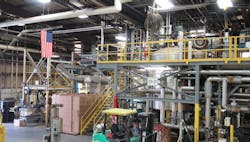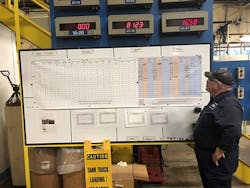Asset Management: Method Spurs Multiple Process Improvements
My family has been in the business of making specialty chemicals for more than a century. We thought we knew our processes. Over the last year, we found out that we were very wrong — and very right.
We had an opportunity to pursue a new product line. However, doing so was feasible only if we could free up some underused capacity. Eric Brown, our head of U.S. operations, suggested we contact QualPro, a company he had dealt with extensively in his previous job at DuPont. We engaged the firm to train and support our staff on the use of QualPro’s MVT Process, which provides a way for local production staff to quickly identify and test dozens of feasible, practical, cost-free and safe process changes. QualPro consultant Art Hammer led our project.
The results of our first project were so dramatic that we felt as if we were building a new factory without spending a dime. Later projects brought equally profound improvements to production of our number-two product, as well as to our wastewater treatment and measurement practices.
During the early stages of one of these projects, I spoke with an operator, who said something that many of our people must have thought: “We’ve been running this process for 50 years. If we don’t know how to do it by now, we shouldn’t be in business.”
What we learned is that we do know how to do it. We, ourselves, had the solutions already; we just needed the proper way to ask the questions and discover the correct answers. We also learned to ask the right people: the ones who are running the process at 3 o’clock in the morning — when the executives and engineers are sound asleep.
Learning A New Method
The MVT approach is based on sophisticated statistics and experimental design but QualPro has made that power accessible without fancy software or calculations. Everyone on our teams, from PhD chemist to young operator, learned the method comfortably in two four-day training sessions. Many emerged as enthusiastic converts.
This statistically based test strategy automatically separates the “critical few” from the “trivial many.” Data are collected by hand on paper during normal production; identifying what’s significant is just a matter of addition, subtraction and division. The result is a predictive equation based on the significant variables. The real work is coming up with things to try. To do that, the key is listening to every person and every idea equally.
As an onlooker, it was fascinating to see the “teamness” that emerged as our staff worked together. Everybody was fully and freely participating without fear or concern about looking stupid or about rank or position. At a hands-on demo recently, an operator sat by my father, the former CEO, eagerly explaining how to calculate which factors were significant.
Dramatic First Result
Our initial MVT project involved one of our older products, a rubber adhesion promoter used primarily for helping bond rubber to steel belts in radial tires. Its production process is complicated, volatile and time-consuming — and requires dedicated lines. However, because of market changes, one of these dedicated lines was idle three-quarters of the time. We were very motivated to do whatever it took to consolidate production.
The goal of the project was to reduce cycle time. Historically, reactor time averaged 127 hours. We needed to trim that by 22 hours or about 18%. By using the MVT methodology, we far exceeded that goal. Our employees cut cycle time by 85 hours or 67% — to only 42 hours.
In a few short brainstorming sessions, the team came up with 93 ideas for changes that might affect the process. About a quarter of these received further consideration because they met QualPro’s criteria — practical, fast and cost-free. We tested more than 20 ideas. Of these, six helped shorten the cycle time. Hourly workers had suggested four of the six.
This project opened our eyes to the opportunities we can find by looking closely at every single thing we do. It also gave us the confidence to experiment.
Figure 1. Mike Ritter, lead operator on the effort, was impressed by the method and its results — a more than doubling of capacity.
Mike Ritter (shown in Figure 1), who was lead operator on the adhesion-promoter project, raved: “I have seen every program in the last 30 years. This is completely different. This was built with us — the local work force — from day one. It started with us. Our ideas were the foundation. We tested our ideas in our world, not some simulation or computer program. Everything we tested was practical, fast, cost-free and safe. We, the operators, calculated the results. We saw what worked and what didn’t. Our ideas cut cycle time in half and improved quality at the same time, and we don’t work any harder.”
Much Better Yield
Needless to say, with results like that, word got around the company. We turned our new skills and perspective to one of our anchor products, an infrared-reflecting black pigment used for architectural exteriors. This pigment helps keep buildings cooler, reducing energy use for air conditioning.
It’s one of our most challenging products. The materials don’t tolerate excessive heat or grinding, and the process requires about 20 steps over eight equipment trains (some shared) in multiple locations. Our goal was to improve the yield of premium grade by decreasing variability and, thus, limiting blending and rework.
Out of 88 candidate factors, we designed a 31-factor MVT. That sounds large but QualPro’s methodology handles 30+ factors easily. The test yielded seven significant factors — some completely unexpected — that have increased the yield of our highest premium grade to 93% from 14%. In addition to eliminating expensive post-processing, we now can provide a more uniform product to customers whose own processes may be sensitive to variability.
To produce this pigment, iron and chromium are dry blended; the blend is fed to a calciner, milled and (in some cases) washed. The product then goes into ceramic boxes called saggers, which are stacked by robots for kiln firing. The load/fire/unload cycle takes two days.
In this project, we discovered the “reality check” benefits of the MVT methodology. In preparing for the tests, we found that we didn’t have the necessary level of control over two factors: the feed rate for the jet mill and the air-to-gas ratio for the kilns. The jet mill average feed rate was stable — but the operators weren’t able to stabilize around a particular value. The issue was traced to a loss-in-weight feeder. For the kilns, we learned that valves were stuck open because certain filters were clogged with colored dust. Because of the stuck valves, we were losing all benefit from programmable logic control of the air-to-gas ratio. The filter issue illustrates the importance of not only having a preventive maintenance schedule but also watching its performance with operator-kept control charts.
We also came to understand how crucial it is to be open to every idea that comes up in brainstorming. We had everyone predict which factors they thought would be important. Almost everybody chose two factors, raw blend time and a blend/pulverize/blend sequence, which had been the focus of earlier process improvement work. These two factors turned out to be near the bottom in significance. Only one person reckoned that the particular spray dryer we used would have any impact — when, in fact, it was the second most important factor. The moral of the story: Don’t assume.
Pete Resnick, product line engineering leader, comments: “One of the things I like about this process is that the people who actually turn the knobs and open the valves are participating in the brainstorming. They might not have the statistical background to know all the reasoning behind the equations, but they know everything they’ve got to do to make that process run — and sometimes that’s not in a procedure. A lot of times, an engineer or an R&D person doesn’t have that information, so you might miss some very key factors if you don’t have those individuals in the room.”
The Benefits Keep Coming
We have applied the MVT process to achieve several other impressive results very quickly.
• We wanted to lower the levels of total copper in the wastewater to give us a bigger safety range between typical levels and the upper specification. Engineers, chemists and our local workers defined 15 factors for a test in the plant’s water treatment facility. Adjusting just three factors reduced total copper levels by 78%.
• As part of preparation for another MVT, we discovered that NOx emissions from one process were inching up. In less than 72 hours, the local workforce brainstormed factors, set up an MVT, executed it and implemented the necessary changes to bring NOx emissions back in line.
• In another demonstration of the importance of measurement, the laboratory staff did an MVT that reduced variation in color measurement by 88% — with the resulting improvements incurring no extra costs or time.
All our customers benefit from the improvements we’re making. Our products now boast less variation in characteristics and, therefore, are easier for our customers to use. In addition, we’ve become even more reliable in product delivery. Both improvements on our side help reduce our customers’ total cost, enabling them to offer better products at a better price, to the benefit of the ultimate consumer.
My Takeaway
The key to getting maximum benefit from process improvement is putting effort into changing the right things. Before a test, each person on the team was invited to guess which factors would really matter. What really struck me was (a) that we guessed poorly and (b) that the other executives and I guessed especially poorly. I took two management lessons away from our work with MVT:
1. Don’t assume; test.
2. Listen to every idea.
At Shepherd, our goal is to be an employer of choice, hiring capable, hard-working people and paying them well. I’m frustrated that our normal operations don’t always make full use of their talents. In the MVT process, we leverage the wisdom, experience and natural intelligence of everyone in the plant. They take complete ownership of their achievements, and feel fulfilled and appreciated. The findings are profound. Our business stays competitive in the global marketplace, and we can continue to offer a quality workplace. As someone who believes that some of the best jobs in the world are in American manufacturing, I find those accomplishments really gratifying.
TOM SHEPHERD is CEO of Shepherd Material Science Co., Cincinnati. Email him at [email protected].

